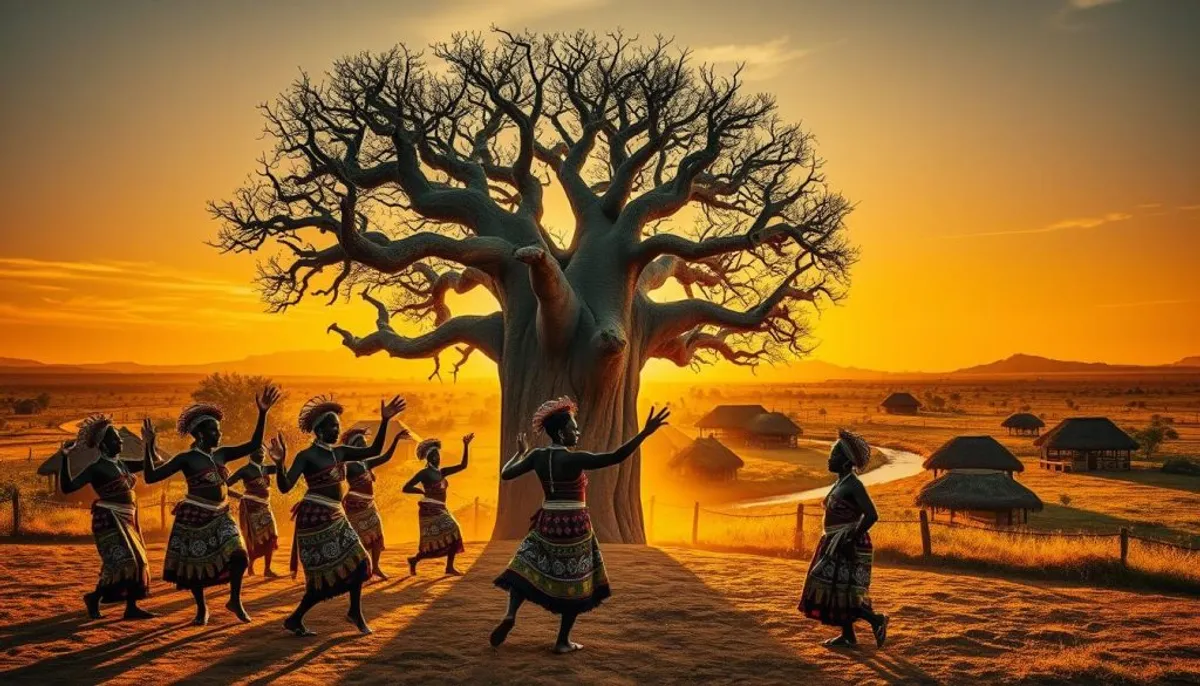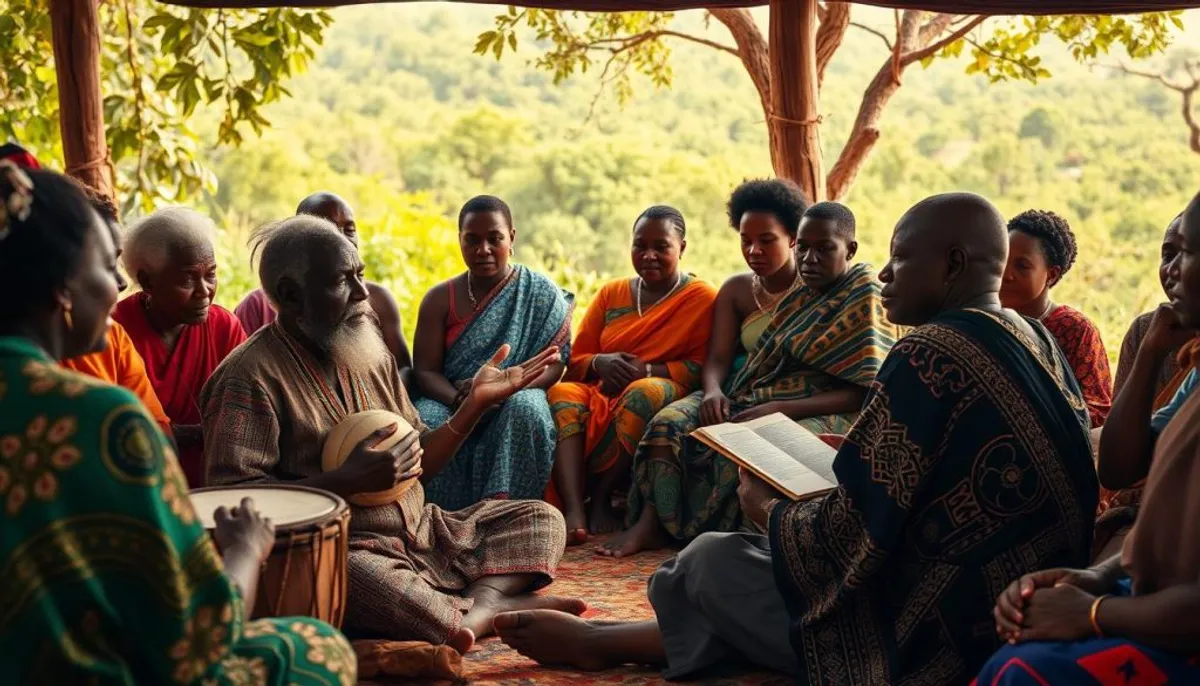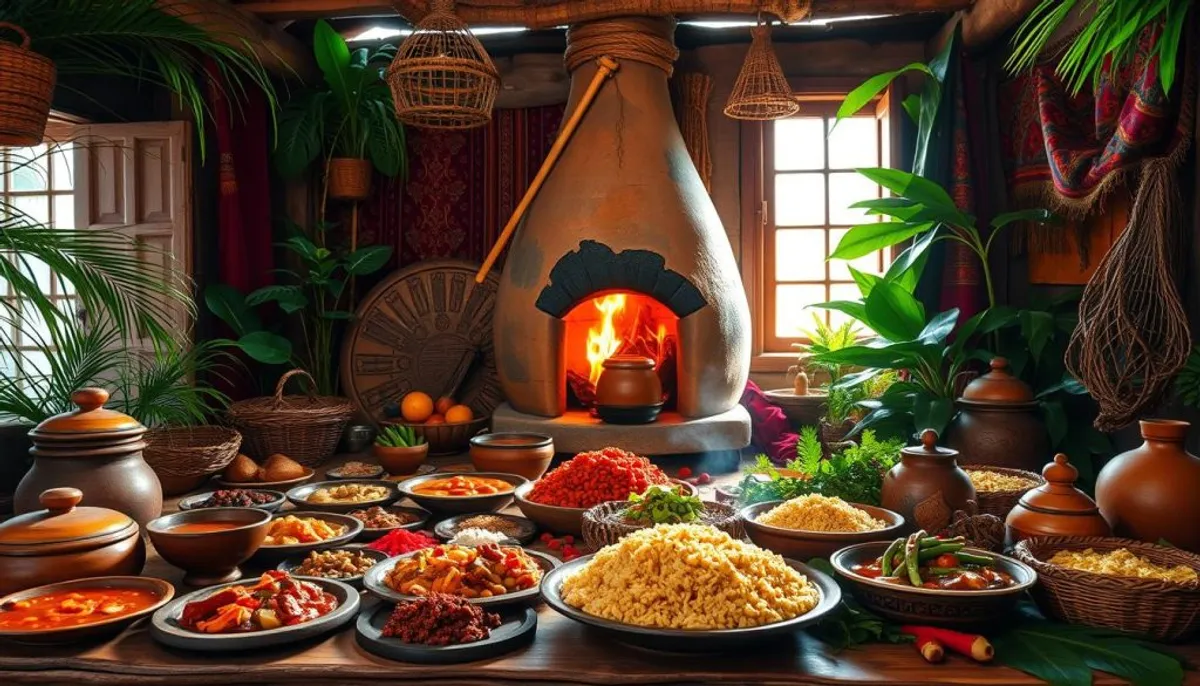
The African culture represents an invaluable heritage, rich in traditions and ancestral wealth. This continent, with its exceptional diversity, is home to a multitude of peoples, languages, and customs. In South Africa, for example, there are about thirty ethnic groups, and more than a dozen religions coexist on its soil.
African culture is a unique blend. It includes oral traditions, arts, music, and a profound spirituality. In Africa, 85% of traditional knowledge is passed down orally. This oral transmission is so precious that it is often said: “In Africa, when an elder dies, it is a library that burns.”
African traditions encompass a set of beliefs and social values passed down from generation to generation. They shape the identity of peoples and influence all aspects of daily life. The richness of this culture is reflected in the diversity of artistic expressions, spiritual rituals, and systems of ancestral knowledge.
What is African culture: an exceptional diversity
African culture is a true treasure of diversity, reflecting a rich and varied heritage. With over 3000 ethnic groups and 2000 languages, Africa is a fascinating cultural mosaic. This diversity manifests itself in all aspects of daily life, from traditions to artistic expressions.
The rainbow nation: a unique blend of peoples
South Africa perfectly embodies this diversity. Nicknamed the “rainbow nation,” it brings together peoples of varied origins. This heterogeneity, a source of conflict in the past, is now celebrated as an invaluable wealth. It illustrates the continent's ability to transform its challenges into assets.
The multiple cultural heritage of Africa
The African heritage is the result of centuries of exchanges and influences. From the Pygmies of the equatorial forest to the communities of the Sahel, each group has contributed to shaping the continent's identity. This diversity is reflected in music, where 80% of traditions are transmitted orally, thus preserving unique ancestral knowledge.
The harmonious coexistence of traditions
Despite differences, African culture is based on common values. The importance of community, respect for elders, and spirituality are shared pillars. This harmonious coexistence is manifested in art, music, and rites. For example, the lithophones of the Kabiyé testify to ancient musical traditions that are still vibrant, symbols of a preserved and valued cultural diversity.
The spiritual foundations of African society
African spirituality is deeply rooted in daily life, shaping the beliefs and practices of millions. This spiritual tradition has withstood historical upheavals, including the slave trade. The latter uprooted nearly 12 million Africans between 1450 and 1900.
Traditional African religions
Traditional African religions stand out for their diversity and their connection to nature. They are based on the belief in a supreme being, ancestral spirits, and natural forces. Despite the growing influence of monotheistic religions, these beliefs have survived.
The influence of ancestral beliefs
Ancestral beliefs play a crucial role in today's African society. They manifest in mythology, tales, and proverbs passed down orally. This oral transmission has preserved ancestral wisdom in the face of social changes.
The role of rituals in daily life
Rituals play a central role in African life. They mark key milestones of existence, from birth to death, including initiations and marriages. These ceremonies strengthen community bonds and ensure cultural continuity. African spirituality is also expressed in daily gestures, reminding us of the sacred link between man and his environment.
Art and cultural expression in Africa
African art is an invaluable treasure, reflecting the richness and diversity of the continent. It ranges from ancient rock paintings to contemporary creations. African artistic expression has evolved over millennia, profoundly marking African cultural history.
The earliest traces of African art date back over 10,000 years. The rock paintings of Tassili n'Ajjer, dating from 9,000 to 10,000 years ago, illustrate the ingenuity of early artists. The culture of the “Round Heads,” around 4000 BCE, is distinguished by its impressive-sized paintings.
African art has diversified over time. The Nagada statues in ancient Egypt, the Nok figurines from Nigeria, and the art of Djenné illustrate this evolution. Ritual objects, such as Kwele masks or Baoulé pulleys, play a crucial role in local traditions.
| Period | Artwork | Origin | Dimensions |
|---|---|---|---|
| 3800-3100 BCE | Nagada Statues | Ancient Egypt | 50 cm and 31.4 cm |
| 500 BCE – 500 CE | Nok Figurine | Nigeria | 38 cm |
| 13th – 15th century | Djenné Statuette | Mali | 37.5 cm |
| Early 20th century | Kwele Mask | Not specified | 63 cm |
Today, African art is experiencing a revival. Galleries like Cécile Fakhoury and Houkami Guyzagn promote contemporary artists. African capitals, from Abidjan to Cape Town, are seeing new spaces for artistic expression flourish. This cultural effervescence makes Africa an essential destination for art lovers.
The transmission of ancestral knowledge
The oral tradition is fundamental for the preservation of African culture. It ensures the transmission of history, myths, and knowledge from one generation to the next. This ancestral method is essential in many African societies.
The importance of oral tradition
In Africa, the spoken word is considered sacred. Griots, storytellers, and guardians of collective memory play a crucial role. They transmit the stories and legends that shape the identity of peoples. In Gabon, with its 40 ethnic groups, the oral tradition is a pillar of culture.

The role of elders in education
Elders play a central role in traditional African education. They are the bearers of wisdom and customs. Their role is essential in initiation societies, such as Bwete in Gabon. There, knowledge is transmitted over several years.
Initiation ceremonies
Initiation rites mark crucial stages in the lives of young Africans. These ceremonies allow for the transmission of values and cultural knowledge, including those related to the Spanish language. In Gabon, there are at least 20 initiation societies, each contributing to the preservation of traditions.
The transmission of ancestral knowledge is a challenge in the face of social transformations. However, it remains essential for sustainable development and the preservation of African cultural identity.
Music and dance: the soul of Africa
African music and dance embody the essence of African culture. They reflect the diversity and depth of ancestral traditions. In Côte d'Ivoire, the music scene is particularly dynamic, with album sales reaching 300,000 to 400,000 copies for the most famous artists.
The djembe, nicknamed “the talking instrument,” plays a central role in African music. Its rhythms are used to announce news, coordinate community activities, and even resolve conflicts. It is essential during important ceremonies such as weddings, baptisms, and funerals.
African dancing, a millennia-old heritage, is divided into a multitude of styles. It encompasses ritual, social, and transitional dances. Today, contemporary African dance draws inspiration from European and Afro-American styles, creating unique fusions.
| Aspect | Role in African culture |
|---|---|
| Djembe | Communication, ceremonies, healing |
| Dance | Cultural expression, rites of passage, contemporary fusion |
| Music | Cultural identity, transmission of knowledge, international influence |
African music and dance continue to influence global culture. Artists like Beyoncé and Rihanna incorporate elements of African dance into their performances. Collaborations between African and international artists foster enriching cultural exchange.
African gastronomy and culinary art
African cuisine, a true culinary adventure, is rich in traditions and flavors. It takes us through iconic dishes and collective preparations. Let’s discover the gastronomic treasures of the continent together.
Traditional dishes and their symbolism
Each region of Africa has its unique specialties. Malian mafé, Senegalese yassa, and Cameroonian chicken DG tell the story and culture of their countries. These recipes, passed down from generation to generation, keep African culinary traditions alive.

The art of collective preparation
In Africa, cooking is a social activity. Meals are prepared with family or friends, strengthening community bonds. The tradition of sharing is reflected in dishes like Senegalese thiéboudienne, designed to feed large groups, while also celebrating the Haitian culture that also shares this value of conviviality.
Mixed culinary influences
African cuisine has enriched over time through cultural exchanges. Its influence can be found in many dishes around the world. The gumbo of New Orleans and Brazilian acarajé testify to this culinary blending. These traditions travel and adapt, creating new flavors while preserving their African essence.
To discover these gastronomic wonders, events like the Food Temple Festival in Paris highlight African cuisine. Chefs like Tamsir Ndir, with 30 years of experience, share their expertise and passion for these ancestral culinary traditions.
Social and family organization
The African social structure is rooted in the extended family, a pillar of tradition. This system offers invaluable support and solidarity. However, it can also limit individual development. A 1962 study revealed that 33% of black students in France regretted their “social background” and 31% their family.
In rural areas, the extended family retains its importance. It is essential in the education of children and the transmission of values. But, in the face of modern challenges, this model is evolving. Young urbanites, for example, find it difficult to save due to constant family demands.
The traditional social hierarchy persists in some regions. In Wallis, society is divided between aliki (nobles) and tua (commoners). The King and his council of six ministers govern, assisted by district and village chiefs. Each clan respects an age hierarchy and participates in customary events.
The family economy relies on subsistence agriculture, fishing, and livestock. A typical habitat includes a house, a kitchen, and an oven. Family gardens produce bananas, taros, and cassava year-round. This food self-sufficiency strengthens family and community ties, pillars of African tradition.
Conclusion
Africa, the cradle of humanity, is a continent with a thousand cultural facets. Its heritage, rich and varied, reflects a millennia-old history. This history continues to shape its present. The diversity of traditions, languages, and artistic expressions makes Africa a true cultural kaleidoscope.
The challenges of modernity affect this continent. Education is crucial for preserving African identity. Many experts recommend reorganizing educational systems. They wish to integrate local languages and traditional knowledge.
This approach strengthens the bonds between youth and their cultural heritage. Today's Africa is the result of a complex blending. The distribution of blood groups across the continent bears witness to this.
This biological diversity is reflected in the cultural richness of its peoples. Despite the challenges, Africa asserts itself on the global stage. It does so through its unique heritage and its ability to combine tradition and modernity.
RelatedRelated articles


